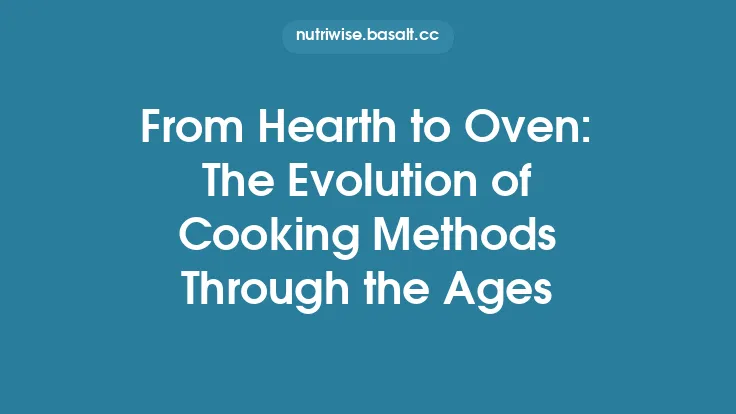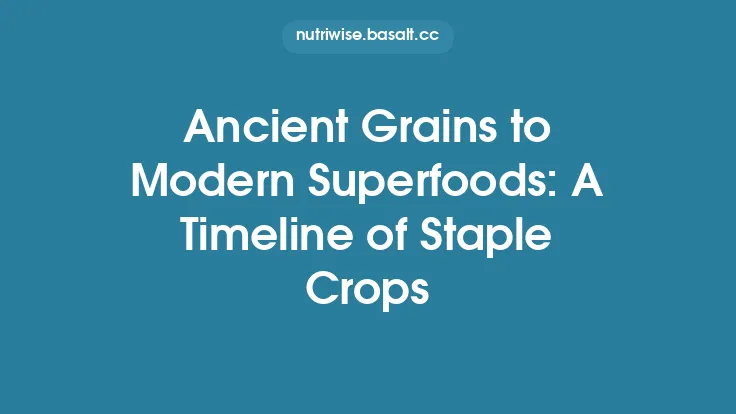The story of what humans have eaten stretches back over two million years, weaving together biology, environment, technology, and culture. From the opportunistic foraging of our ancestors to the data‑driven nutrition plans of today, each epoch left an imprint on the collective palate and on the physiological adaptations that still shape modern health.
Paleolithic Foundations (c. 2 million – 10 000 BCE)
The earliest hominins survived on a diet dictated by availability, seasonality, and the energetic demands of a mobile lifestyle. Archaeological sites and stable‑isotope analyses of fossilized bone collagen reveal a high reliance on animal protein and fat, supplemented by wild plant foods such as tubers, nuts, and fruits. Key characteristics of this period include:
- Macronutrient balance: Rough estimates suggest 20–35 % of calories from protein, 30–45 % from fat, and 25–35 % from carbohydrates, though the exact ratios varied widely by region and climate.
- Food processing: Simple tools enabled meat slicing, marrow extraction, and the roasting of tubers. Early fire use (≈ 1 M BCE) dramatically increased nutrient bioavailability and reduced pathogen load.
- Physiological adaptations: The human gut evolved a relatively long small intestine for efficient nutrient absorption, while the large intestine retained capacity for fermenting resistant starches and fiber, supporting a diverse microbiome.
These adaptations laid the groundwork for later dietary flexibility, allowing humans to thrive in environments ranging from the African savanna to the Siberian tundra.
The Neolithic Revolution and the Birth of Agriculture (c. 10 000 – 3 000 BCE)
The transition from foraging to farming marks a watershed in dietary history. Domestication of cereals (wheat, barley, rice, maize) and legumes (lentils, peas, beans) introduced a reliable, storable food source, but also reshaped nutrient intake:
- Carbohydrate dominance: Staple grains became the primary energy source, often contributing 60 % or more of daily calories in agrarian societies.
- Reduced dietary diversity: Reliance on a few crops lowered intake of micronutrients such as zinc, iron, and certain B‑vitamins, leading to deficiencies like iron‑deficiency anemia and pellagra in later periods.
- Technological advances: Grinding stones, mortars, and later, watermills increased the digestibility of grains, while fermentation (e.g., sourdough) improved nutrient bioavailability and introduced probiotic benefits.
The shift also spurred physiological changes, including a modest reduction in average stature and dental health issues linked to higher carbohydrate consumption.
Ancient Civilizations and Food Systems (c. 3 000 BCE – 500 CE)
Complex societies in Mesopotamia, the Indus Valley, Egypt, China, and the Americas built elaborate food production and distribution networks:
- Diversified agriculture: Irrigation, crop rotation, and the introduction of new species (e.g., millet, sorghum, quinoa) expanded the dietary repertoire.
- Animal husbandry: Domesticated livestock (cattle, sheep, goats, pigs) supplied meat, milk, and eggs, rebalancing the protein–fat ratio and providing essential fatty acids such as omega‑3s from dairy.
- Trade and exchange: Long‑distance trade routes (e.g., the Silk Road) facilitated the spread of spices, legumes, and fruit varieties, enriching regional cuisines and introducing phytochemicals with antioxidant properties.
Nutritional knowledge began to emerge in written form, with early medical texts (e.g., the Ayurvedic “Sushruta Samhita” and the Greek “Hippocratic Corpus”) linking diet to health outcomes.
Classical Antiquity and the Rise of Market Economies (c. 500 BCE – 500 CE)
Greek city‑states and the Roman Empire refined food markets, storage, and culinary techniques:
- Urban diets: Access to fish, olives, and wine in Mediterranean ports provided monounsaturated fats and polyphenols, while grain imports sustained city populations.
- Preservation methods: Salting, smoking, and drying extended the shelf life of meat and fish, influencing protein intake patterns.
- Culinary codification: Recipes and dietary recommendations began to appear in texts such as “De Re Coquinaria,” reflecting an early understanding of food pairing and seasonal eating.
These practices set precedents for later food logistics and the concept of a “balanced” diet, albeit without modern nutritional science.
Medieval Foodways (c. 500 – 1500 CE)
Feudal economies and limited transportation shaped regional diets across Europe, the Middle East, and Asia:
- Seasonal reliance: Harvest cycles dictated consumption; winter months often saw increased reliance on preserved foods (e.g., salted pork, pickled vegetables) and legumes.
- Grain hierarchy: White wheat flour, reserved for the elite, contrasted with coarser whole‑grain breads for the peasantry, affecting fiber intake and glycemic response.
- Spice trade: The influx of exotic spices (pepper, cinnamon, cloves) introduced bioactive compounds that may have modest anti‑inflammatory effects.
While culinary diversity grew, overall caloric intake remained modest for most, with periodic famines highlighting the vulnerability of agrarian societies to climate variability.
Early Modern Era and Global Food Exchange (c. 1500 – 1800 CE)
The Age of Exploration ignited an unprecedented exchange of crops, reshaping global nutrition:
- Columbian Exchange: Introduction of potatoes, tomatoes, maize, and cacao to Europe and Asia, and wheat, rice, and livestock to the Americas, dramatically altered macronutrient profiles.
- Caloric impact: High‑energy crops like potatoes and maize boosted caloric availability, supporting population growth in Europe and parts of Asia.
- Nutrient diversification: New fruits (e.g., pineapples, citrus) increased vitamin C intake, reducing scurvy incidence among seafarers and later among inland populations.
These shifts laid the foundation for modern staple foods and contributed to the demographic transition that preceded industrialization.
The Industrial Age and the Advent of Processed Foods (c. 1800 – 1950 CE)
Mechanization, urbanization, and advances in food science transformed how people ate:
- Mass production: Milling technologies refined grain into white flour, reducing fiber and micronutrient content; refined sugars became widely available.
- Preservation breakthroughs: Canning, refrigeration, and later, freeze‑drying extended food shelf life, enabling year‑round consumption of previously seasonal items.
- Nutrient fortification: In response to identified deficiencies, governments introduced fortification programs (e.g., iodized salt, vitamin‑D‑fortified milk), improving public health outcomes.
While food availability increased, the rise of energy‑dense, nutrient‑poor products contributed to emerging concerns about obesity and chronic disease later in the century.
Late‑20th‑Century Nutrition Science and Dietary Shifts (c. 1950 – 2000 CE)
Post‑World‑II prosperity and scientific breakthroughs reshaped dietary guidance:
- Macronutrient research: Studies on lipid metabolism clarified the roles of saturated versus unsaturated fats, influencing public health recommendations.
- Dietary guidelines: National nutrition policies introduced food‑based pyramids and plate models, emphasizing portion control and food group balance.
- Emergence of specialty diets: Low‑carbohydrate, high‑protein, and other regimen trends reflected both scientific curiosity and consumer desire for weight management.
Simultaneously, the global food supply chain expanded, making exotic produce and processed snacks accessible worldwide, further diversifying dietary patterns.
21st‑Century Dietary Trends and Future Directions
Today’s diet landscape is defined by a tension between abundance and health consciousness:
- Personalized nutrition: Genomic, metabolomic, and microbiome profiling enable tailored dietary recommendations, moving beyond one‑size‑fits‑all guidelines.
- Sustainable eating: Concerns about climate impact drive interest in plant‑forward meals, reduced meat consumption, and alternative protein sources (e.g., cultured meat, insect protein).
- Technology‑mediated food: Meal‑kit services, AI‑driven recipe platforms, and blockchain‑verified supply chains aim to improve food safety, transparency, and convenience.
- Nutrient density focus: Emerging dietary frameworks (e.g., the “Nutrient Density Index”) prioritize foods rich in vitamins, minerals, and bioactive compounds while limiting added sugars, refined grains, and ultra‑processed ingredients.
Research continues to uncover how early‑life nutrition, epigenetic modifications, and gut microbiota interactions influence long‑term health, suggesting that the evolutionary story of our diet is still being written.
Reflections on the Evolutionary Arc
From the high‑protein, high‑fiber meals of Paleolithic hunters to the hyper‑processed, calorie‑dense foods of modern supermarkets, human diets have constantly adapted to environmental pressures, technological innovations, and cultural values. Each transition brought both benefits—greater food security, increased variety, improved nutrient availability—and challenges—micronutrient deficiencies, metabolic disease, and ecological strain.
Understanding this timeline equips us to make informed choices that honor our biological heritage while addressing contemporary health and sustainability goals. By recognizing the forces that have shaped our eating patterns, we can better navigate the complex food landscape of the present and future.





